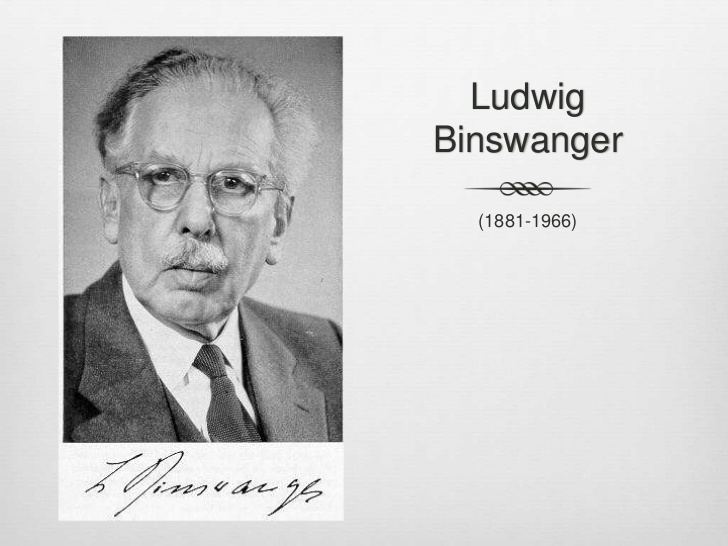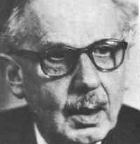Name Ludwig Binswanger | ||
 | ||
Influences Martin HeideggerEdmund HusserlMartin Buber Books Being-in-the-world: Selected Papers of Ludwig Binswanger Similar People | ||
Ludwig binswanger
Ludwig Binswanger (April 13, 1881 – February 5, 1966) was a Swiss psychiatrist and pioneer in the field of existential psychology. His grandfather (also named Ludwig Binswanger) was founder of the "Bellevue Sanatorium" in Kreuzlingen, and his uncle Otto Binswanger was a professor of psychiatry at the University of Jena.
Contents
- Ludwig binswanger
- Ludwig binswanger psicologia
- Life and career
- Thinking and influence
- Binswanger on existence
- Modes of existence
- Weltanschauung
- Being in the world vs being beyond the world
- Criticism
- Works
- German edition of selected works
- References
He is considered the most distinguished of the phenomenological psychologists, and the most influential in making the concepts of existential psychology known in Europe and the United States.

Ludwig binswanger psicologia
Life and career

In 1907 Binswanger received his medical degree from the University of Zurich. As a young man he worked and studied with some of the greatest psychiatrists of the era, such as Carl Jung, Eugen Bleuler and Sigmund Freud. He visited Freud (who had cited his uncle Otto's work on Neurasthenia) in 1907 alongside Jung, approvingly noting his host's "distaste for all formality and etiquette, his personal charm, his simplicity, casual openness and goodness". The two men became lifelong friends, Freud finding Binswanger's 1912 illness "particularly painful", and Binswanger offering Freud a refuge in Switzerland in 1938.
Binswanger became a member of the early 'Freud Group' Jung led in Switzerland; but nevertheless wrestled throughout his life over the place of psychoanalysis in his thinking - his 1921 article on 'Psychoanalysis and clinical Psychiatry' being only one landmark of that lifelong struggle.
Binswanger was further influenced by existential philosophy, particularly after WWI, through the works of Martin Heidegger, Edmund Husserl, and Martin Buber, eventually evolving his own distinctive brand of existential-phenomenological psychology.
From 1911 to 1956, Binswanger was medical director of the sanatorium in Kreuzlingen.
Thinking and influence
Binswanger is considered the first physician to combine psychotherapy with existential and phenomenological ideas, a concept he expounds in his 1942 book; Grundformen und Erkenntnis menschlichen Daseins (Basic Forms and the Realization of Human "Being-in-the-World"). In this work he explains existential analysis as an empirical science that involves an anthropological approach to the individual essential character of being human.
Binswanger saw Husserl's concept of lifeworld as a key to understanding the subjective experiences of his patients, considering that "in the mental diseases we face modifications of the fundamental structure and of the structural links of being-in-the-world". For Binswanger, mental illness involved the remaking of a world - including alterations in the lived experience of time, space, body sense and social relationships. Where for example the psychoanalyst might only see "an overly strong 'pre-oedipal' tie to the mother", Binswanger would point out that "such overly strong filial tie is only possible on the premise of a world-design exclusively based on connectedness, cohesiveness, continuity".
Binswanger's Dream and Existence — which was translated from German into French by Michel Foucault who added a substantial essay-introduction — highlighted in similar fashion the necessity of "steeping oneself in the manifest content of the dream - which, since Freud's epoch-making postulate concerning the reconstruction of latent thoughts, has in modern times receded all to[o] far into the background". Eugene Minkowski had earlier introduced Binswanger's ideas into France, influencing thereby among others the early work of Jacques Lacan.
In his study of existentialism, his most famous subject was Ellen West, a deeply troubled patient whose case-study was translated into English for the 1958 volume Existence. Binswanger ascribed "schizophrenia" to her, and her case is included in his book "Schizophrenie". But few contemporary psychiatrists would accept this diagnosis. "Anorexia nervosa" is also misplaced. She felt an extreme urge for weight loss.
Through his adoption from Buber of the importance of the concept of dialogue, Binswanger can also be seen as an ancestor to intersubjective approaches to therapy. Binswanger emphasised the importance of mutual recognition, as opposed to the counterdependency of destructive narcissism, as described by Herbert Rosenfeld for example.
Binswanger on existence
Ludwig Binswanger contributed much to the idea of existence in the school of existential psychology. He believed that human existence was complex in that one has control over how one exists. As he described, humans have the choice of existing as,"being a hunter, of being romantic, of being in business, and thus (we are) free to design (ourselves) toward the most different potentialities of being." He therefore believed that such an existence "transcends the being," making the being accessible to itself in numerous different outcomes in life based on the existential path one chooses. In addition to this belief, Binswanger also thought that you can only observe one's existence and/or unique personality by looking at it holistically, emphasized in this quote from Binswanger:
"It is a question of attempting to understand and to explain the human being in the totality of his/her existence. But that is possible only from the perspective of our total existence: in other words, only when we reflect on and articulate our total existence, the "essence" and "form" of being human."
.
Modes of existence
Binswanger argued that there are certain modes of existence. These modes of existence, he believed, allowed humans and non-human animals to be separated based on this concept. These modes include:
The Umwelt can apply to both non-human animals and humans. It is the relationship between the organism and its environment. However, according to Binswanger, non-human animal cannot possess the world as humans do. Non-human animals, "can neither design world nor open up world nor decide independently in and for a situation. As for humans, they do possess the world in the way that they can transcend their being above the level of non-human animals by, "climbing above it (the world) in care and of swinging beyond it in love."
The Mitwelt refers to the mode of existence involved in inter-species relations. Specifically, this mode applies mainly to humans in the sense of human interaction. It also refers to the "shared world" that we have with other people,i.e., viewing our lives according to our relationships with other humans.
The Eigenwelt refers to a person's own subjective experience, or the "self world." In other words, the Eigenwelt is the relationship that one has with themselves. This mode of existence is the most difficult to grasp because of its vague definition.
Binswanger believed that to fully understand a person, you must take into account the specificities of all three modes of existence.
Weltanschauung
Weltanschauung (world-design) also applies to one's existence. An individual experiences the world through their own Weltanschauung, or world-design. A person's world-design is essentially how they view and open up to the world around them. This concept also is related to the modes of existence, as Binswanger points out:
"The world-design"..."is by no means confined to the environment to the world of things, or to the universe in general, but refers equally to the world of one's fellow men (Mitwelt) and to the self world (Eigenwelt)"
Being-in-the world vs. being-beyond-the-world
Two other concepts relate to Binswanger's view on existence, relating to the relationship between humans and the world or objects around them. Being-in-the-world is, "the normal and lawful interaction with the real-world environment that is considered primary to our way of existing in the world". It explains how we interact with our environment and the impact of that relationship. When "being-in-the-world," there are 3 general steps of assessment:
- Identify the situation in reference to known objects and their properties
- Assign general rules to that situation according to those objects and properties
- Use logical rules in the situation and draw conclusions as to what must be done
Being-beyond-the-world is the second of these concepts. This idea refers to how people can change their circumstances in the world by using free will. Similar to the concept of being-in-the-world, a person is transcended and is able to transform their world following their own motivations. Binswanger relates this idea to love, believing that, "it (love) takes us beyond the world of one's own self to the world of we-hood".
Criticism
R. D. Laing criticised Binswanger's phenomenology of space for insufficiently realizing the extent to which one's sense of space is structured by others.
Fritz Perls criticized Binswanger's existential therapy for leaning too heavily upon psychoanalysis.
